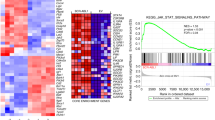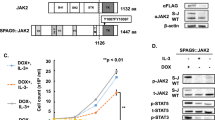Abstract
Oncogenic transformation of hematopoietic cells by the Bcr-Abl oncoprotein directly involves the activation Jak2 tyrosine kinase and the Stat5 transcription factor. Both proteins are normally linked to the interleukin (IL)-3/granulocyte-macrophage colony-stimulating factor receptors for growth and survival. Since fibroblastic cells are not targets of BCR-ABL-induced oncogenesis, we determined whether forced expression of the IL-3 receptor would allow oncogenic transformation of NIH 3T3 fibroblasts known to be resistant to transformation by BCR-ABL. NIH 3T3 cells transduced with the human IL-3 receptor α and β chains were highly susceptible to oncogenic transformation by expression of BCR-ABL. Forced expression of both receptor chains but not either one alone allowed efficient foci formation of NIH 3T3 cells expressing BCR-ABL (triple positive cells), and these cells formed colonies in soft agar, whereas BCR-ABL+ NIH 3T3 cells lacking IL-3 receptor expression did not. Signaling studies indicate that the BCR-ABL/IL-3 receptor+ NIH 3T3 cells utilize the Gab2/PI-3 kinase pathway activated by Jak2, and the Stat5 pathway activated separately by Bcr-Abl, whereas BCR-ABL+ NIH 3T3 cells lacking the IL-3 receptor do not utilize the Jak2 pathway, but still maintain activation of Stat5. The Bcr-Abl kinase inhibitor imatinib mesylate (1 μM) and two Jak2 kinase inhibitors strongly inhibited agar colony formation and the activation of Gab2 caused by Jak2. All of these findings indicate that Bcr-Abl oncoprotein requires the IL-3 receptor/Jak2/Stat5 pathways for oncogenic transformation of NIH 3T3 fibroblasts.
This is a preview of subscription content, access via your institution
Access options
Subscribe to this journal
Receive 50 print issues and online access
$259.00 per year
only $5.18 per issue
Buy this article
- Purchase on Springer Link
- Instant access to full article PDF
Prices may be subject to local taxes which are calculated during checkout





Similar content being viewed by others
References
Daley G, McLaughlin J, Witte ON, Baltimore D . (1987). The CML-specific P210 Bcr/Abl protein, unlike v-abl does not transform NIH 3T3 fibroblast. Science 237: 532–535.
Deininger MW, Goldman JM, Melo JV . (2000). The molecular biology of chronic myeloid leukemia. Blood 96: 3343–3356.
Groffen J, Voncken JW, Kaartinen V, Morris C, Heisterkamp N . (1993). Ph-positive leukemia: a transgenic mouse model. Leuk Lymphoma 11 (Suppl 1): 19–24.
Ilaria Jr RL, Van Etten RA . (1996). P210 and P190 (BCR/ABL) induce the tyrosine phosphorylation and DNA binding activity of multiple specific STAT family members. J Biol Chem 271: 31704–31710.
Klejman A, Schreiner SJ, Nieborowska-Skorska M, Slupianek A, Wilson M, Smithgall TE et al. (2002). The Src family kinase Hck couples BCR/ABL to STAT5 activation in myeloid leukemia cells. EMBO J 21: 5766–5774.
Lugo TG, Witte ON . (1989). The BCR-ABL oncogene transforms Rat-1 cells and cooperates with v-myc. Mol Cell Biol 9: 1263–1270.
Miyamoto N, Sugita K, Goi K, Inukai T, Lijima K, Tezuka T et al. (2001). The JAK2 inhibitor AG490 predominantly abrogates the growth of human B-precursor leukemic cells with 11q23 translocation or Philadelphia chromosome. Leukemia 15: 1758–1768.
Quelle FW, Sato N, Witthuhn BA, Inhorn RC, Eder M, Miyajima A et al. (1994). JAK2 associates with the beta c chain of the receptor for granulocyte-macrophage colony-stimulating factor, and its activation requires the membrane-proximal region. Mol Cell Biol 14: 4335–4341.
Samanta AK, Lin H, Sun T, Kantarjian H, Arlinghaus RB . (2006). Janus kinase 2: a critical target in chronic myelogenous leukemia. Cancer Res 66: 6468–6472.
Sandberg EM, Ma X, He K, Frank SJ, Ostrov DA, Sayeski PP . (2005). Identification of 1,2,3,4,5,6-hexabromocyclohexane as a small molecule inhibitor of Jak2 tyrosine kinase autophosphorylation. J Med Chem 48: 2526–2533.
Sirard C, Laneuville P, Dick JE . (1994). Expression of bcr-abl abrogates factor-dependent growth of human hematopoietic M07E cells by an autocrine mechanism. Blood 83: 1575–1585.
Watanabe S, Itoh T, Arai K . (1997). Roles of JAK kinase in human GM-CSF receptor signals. Leukemia 11 (Suppl 3): 76–78.
Wilson-Rawls J, Xie S, Liu J, Laneuville P, Arlinghaus RB . (1996). P210 Bcr-Abl interacts with the interleukin 3 receptor beta(c) subunit and constitutively induces its tyrosine phosphorylation. Cancer Res 56: 3426–3430.
Xie S, Lin H, Sun T, Arlinghaus RB . (2002). Jak2 is involved in c-Myc induction by Bcr-Abl. Oncogene 21: 7137–7146.
Xie S, Wang Y, Liu J, Sun T, Wilson MB, Smithgall TE et al. (2001). Involvement of Jak2 tyrosine phosphorylation in Bcr-Abl transformation. Oncogene 20: 6188–6195.
Yokota T, Watanabe S, Mui AL, Muto A, Miyajima A, Arai K . (1993). Reconstitution of functional human GM-CSF receptor in mouse NIH3T3 fibroblasts and BA/F3 proB cells. Leukemia 7 (Suppl 2): S102–107.
Acknowledgements
This research was supported in part by funds from CA49639, and funds from the Hubert L Stringer for Cancer Research.
Author information
Authors and Affiliations
Corresponding author
Additional information
Supplementary Information accompanies the paper on the Oncogene website (http://www.nature.com/onc).
Supplementary information
Rights and permissions
About this article
Cite this article
Tao, W., Lin, H., Sun, T. et al. BCR-ABL oncogenic transformation of NIH 3T3 fibroblasts requires the IL-3 receptor. Oncogene 27, 3194–3200 (2008). https://doi.org/10.1038/sj.onc.1210979
Received:
Revised:
Accepted:
Published:
Issue Date:
DOI: https://doi.org/10.1038/sj.onc.1210979
Keywords
This article is cited by
-
The Philadelphia chromosome in leukemogenesis
Chinese Journal of Cancer (2016)
-
A pharmacodynamic model of Bcr–Abl signalling in chronic myeloid leukaemia
Cancer Chemotherapy and Pharmacology (2014)
-
Janus kinase 2 regulates Bcr–Abl signaling in chronic myeloid leukemia
Leukemia (2011)
-
Oncogenic E17K mutation in the pleckstrin homology domain of AKT1 promotes v-Abl-mediated pre-B-cell transformation and survival of Pim-deficient cells
Oncogene (2010)
-
Transcription and signalling pathways involved in BCR–ABL-mediated misregulation of 24p3 and 24p3R
The EMBO Journal (2009)



